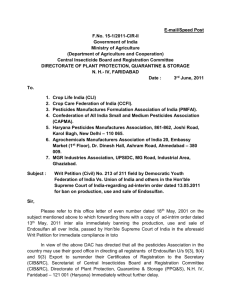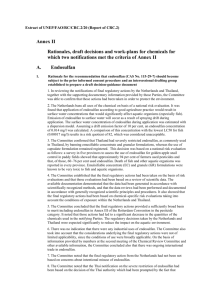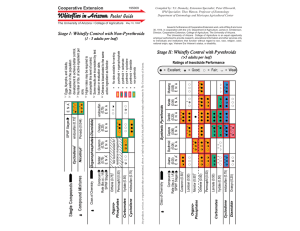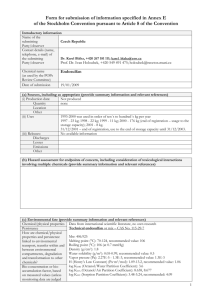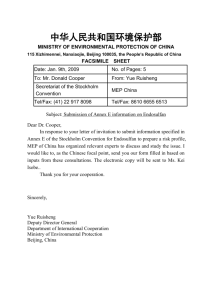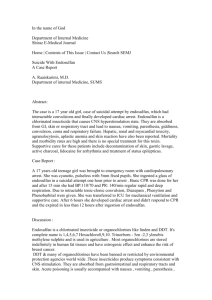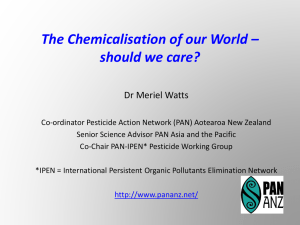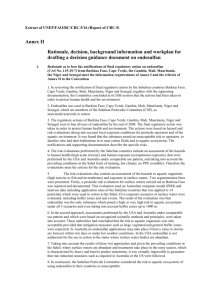British Journal of Pharmacology and Toxicology 3(4): 151-155, 2012 ISSN: 2044-2467
advertisement
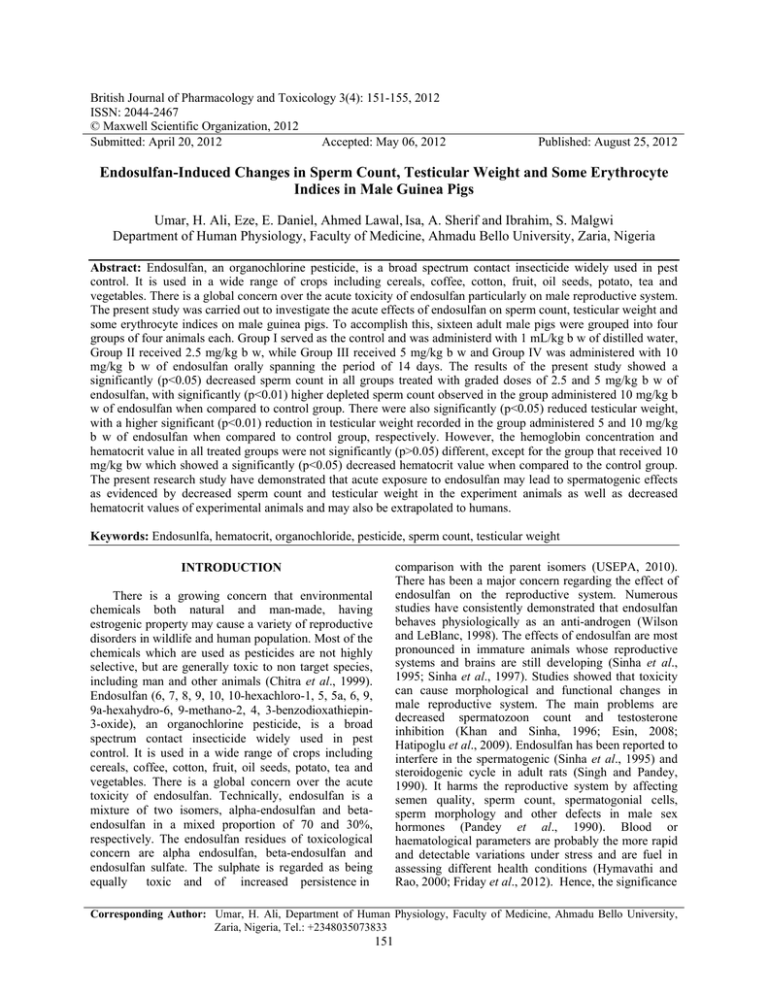
British Journal of Pharmacology and Toxicology 3(4): 151-155, 2012 ISSN: 2044-2467 © Maxwell Scientific Organization, 2012 Submitted: April 20, 2012 Accepted: May 06, 2012 Published: August 25, 2012 Endosulfan-Induced Changes in Sperm Count, Testicular Weight and Some Erythrocyte Indices in Male Guinea Pigs Umar, H. Ali, Eze, E. Daniel, Ahmed Lawal, Isa, A. Sherif and Ibrahim, S. Malgwi Department of Human Physiology, Faculty of Medicine, Ahmadu Bello University, Zaria, Nigeria Abstract: Endosulfan, an organochlorine pesticide, is a broad spectrum contact insecticide widely used in pest control. It is used in a wide range of crops including cereals, coffee, cotton, fruit, oil seeds, potato, tea and vegetables. There is a global concern over the acute toxicity of endosulfan particularly on male reproductive system. The present study was carried out to investigate the acute effects of endosulfan on sperm count, testicular weight and some erythrocyte indices on male guinea pigs. To accomplish this, sixteen adult male pigs were grouped into four groups of four animals each. Group I served as the control and was administerd with 1 mL/kg b w of distilled water, Group II received 2.5 mg/kg b w, while Group III received 5 mg/kg b w and Group IV was administered with 10 mg/kg b w of endosulfan orally spanning the period of 14 days. The results of the present study showed a significantly (p<0.05) decreased sperm count in all groups treated with graded doses of 2.5 and 5 mg/kg b w of endosulfan, with significantly (p<0.01) higher depleted sperm count observed in the group administered 10 mg/kg b w of endosulfan when compared to control group. There were also significantly (p<0.05) reduced testicular weight, with a higher significant (p<0.01) reduction in testicular weight recorded in the group administered 5 and 10 mg/kg b w of endosulfan when compared to control group, respectively. However, the hemoglobin concentration and hematocrit value in all treated groups were not significantly (p>0.05) different, except for the group that received 10 mg/kg bw which showed a significantly (p<0.05) decreased hematocrit value when compared to the control group. The present research study have demonstrated that acute exposure to endosulfan may lead to spermatogenic effects as evidenced by decreased sperm count and testicular weight in the experiment animals as well as decreased hematocrit values of experimental animals and may also be extrapolated to humans. Keywords: Endosunlfa, hematocrit, organochloride, pesticide, sperm count, testicular weight comparison with the parent isomers (USEPA, 2010). There has been a major concern regarding the effect of endosulfan on the reproductive system. Numerous studies have consistently demonstrated that endosulfan behaves physiologically as an anti-androgen (Wilson and LeBlanc, 1998). The effects of endosulfan are most pronounced in immature animals whose reproductive systems and brains are still developing (Sinha et al., 1995; Sinha et al., 1997). Studies showed that toxicity can cause morphological and functional changes in male reproductive system. The main problems are decreased spermatozoon count and testosterone inhibition (Khan and Sinha, 1996; Esin, 2008; Hatipoglu et al., 2009). Endosulfan has been reported to interfere in the spermatogenic (Sinha et al., 1995) and steroidogenic cycle in adult rats (Singh and Pandey, 1990). It harms the reproductive system by affecting semen quality, sperm count, spermatogonial cells, sperm morphology and other defects in male sex hormones (Pandey et al., 1990). Blood or haematological parameters are probably the more rapid and detectable variations under stress and are fuel in assessing different health conditions (Hymavathi and Rao, 2000; Friday et al., 2012). Hence, the significance INTRODUCTION There is a growing concern that environmental chemicals both natural and man-made, having estrogenic property may cause a variety of reproductive disorders in wildlife and human population. Most of the chemicals which are used as pesticides are not highly selective, but are generally toxic to non target species, including man and other animals (Chitra et al., 1999). Endosulfan (6, 7, 8, 9, 10, 10-hexachloro-1, 5, 5a, 6, 9, 9a-hexahydro-6, 9-methano-2, 4, 3-benzodioxathiepin3-oxide), an organochlorine pesticide, is a broad spectrum contact insecticide widely used in pest control. It is used in a wide range of crops including cereals, coffee, cotton, fruit, oil seeds, potato, tea and vegetables. There is a global concern over the acute toxicity of endosulfan. Technically, endosulfan is a mixture of two isomers, alpha-endosulfan and betaendosulfan in a mixed proportion of 70 and 30%, respectively. The endosulfan residues of toxicological concern are alpha endosulfan, beta-endosulfan and endosulfan sulfate. The sulphate is regarded as being equally toxic and of increased persistence in Corresponding Author: Umar, H. Ali, Department of Human Physiology, Faculty of Medicine, Ahmadu Bello University, Zaria, Nigeria, Tel.: +2348035073833 151 Br. J. Pharmacol. Toxicol., 3(4):151-155, 2012 of haematological parameters in clinical and experimental studies in life sciences cannot be overemphasized. Particularly, literature reports have proved that the alterations in the haematological parameters, from normal state, may be used as valuable indicators of disease, or stress in different animal species (Yakubu et al., 2007; Uboh et al., 2005) Assessment of hematological parameters can therefore be used to determine the extent of deleterious effect of foreign substances on the blood constituents of an animal (Friday et al., 2012). The present study was aimed at investigating the acute effect of endosulfan sperm count, testicular weight and some erythrocyte indices in male guinea pigs. MATERIALS AND METHODS Animal care: A total of sixteen adult guinea pigs weighing 300-350 g were purchased from Sabon Gari market in Zaria Kaduna state in the month August, 2006. They were then housed at the Human Physiology Departmental animal house, Ahmadu Bello University Zaria. They were fed with standard commercial feed (a mixture of milled corn, guinea corn, millet and soya beans). The animals were acclimatized for 2 weeks before the commencement of the study. Chemicals used: Endosulfan was obtained from an agrochemical store in Sabon Gari market in Zaria, Kaduna state in the the month of August, 2006. One g of endosulfan was dissolved in 2 mL of propylene glycol. Eight mL of normal saline was then added to prepare 100 mg/L of the solution. This was used as the standard concentration due to the potency of the pesticide. Experimental design: The animals (n = 6) were divided into four groups of four animals each as follows: Group 1: Control and received 1 mL of distilled water Group 2: Received 2.5 mg/kg body weight of Endosulfan Group 3: Received 5 mg/kg body weight of Endosulfan Group 4: Received 10 mg/kg body weight Endosulfan Endosulfan was administered orally by gavage once daily for a period of 14 days. Determination of sperm count: This was determined by the method described by Sinha et al. (2001). Briefly, the guinea pigs were anaesthetized subcutaneously with 1 mL of ketamine hydrochloride prior to dissection to minimize stress. They were then dissected, the testes removed and transferred into petri dish. The adipose tissues, connective tissues and blood vessels were removed from the testes before they were washed with normal saline maintained at 37ºC to remove excess blood. The testes were then weighed before the epididymis was removed. A small incision was made on the cauda epididymis to get the semen from it into a petri dish. One mL of normal saline was added to the semen and mixed thoroughly using a syringe to draw and release the mixture continuously. The semen mixture was then sucked into a red blood cell pipette to the 0.5 mark, then normal saline was sucked up to the 101 mark. The normal saline in the stem of the pipette was discarded and the contents of the bulb of the pipette were mixed thoroughly. A drop of the mixture was placed on the Neubaeur counting chamber which then spreads under the cover slip by capillary action. The counting chamber was then mounted on the slide stage of the microscope and viewed under ×10 magnification. A grid system divides the counting chamber into 5 major squares each containing 16 smaller boxes. The count included all the sperm cells within the 5 major squares using the top and right or left and bottom system of counting. Determination of erythrocyte indices: Erythrocyte indices was determined by the method described by Dacie and Lewis (1991). RESULTS AND DISCUSSION Effect of endosulfan on sperm count of male guinea pigs: Sperm count result showed that treatment of animals with graded doses of 2.5 and 5 mg/kg body weight of endosulfan significantly (p<0.05) reduced the sperm count on the experimental animals when compared to the control group, with a high significant (p<0.01) reduction recorded with 10 mg/kg body weight of endosulfan, as shown in Table 1. Effect of endosulfan on testicular weight of male guinea pigs: The observation made from the results on Table 1 revealed that there was a significantly (p<0.05) decreased testicular weight on administration of 2.5 mg/kg body weight of endosulfan, with a higher significant (p<0.01) decrease of testicular weight recorded with 5 mg and 10 mg/kg body weight of endosulfan when compared with the control group. Effect of endosulfan on change in body weight of male guinea pigs: The study showed that there was a significantly (p<0.05) increased body weight in the 152 Br. J. Pharmacol. Toxicol., 3(4):151-155, 2012 Table 1: Effect of endosulfan on sperm count, testicular weight and change on body weight in male guinea pigs Sperm count Testicular Body Group (n = 4) Treatment given (millions/mL) weight (g) weight (g) 1 Control (distilled water) 86.50±0.87 1.36±0.19 337.0±35.08 2 Endosulfan 2.5 mg/kg b w 62.25±1.78a 0.84±0.07a 394.75±35.0a 3 Endosulfan 5 mg/kg b w 47.75±1.38b 0.57±0.50b 358.75±31.9ns 0.60±0.06b 408.75±65.1b 4 Endosulfan 10 mg/kg b w 29.00±0.91b a b Values are presented as mean±SEM; Values are statistically significant compared to control group at : p<0.05; : p<0.01; ns: not significant Table 2: Effect of endosulfan on some erythrocyte indices in male guinea pigs Group (n = 4) Treatment given H b (g/dL) PCV (%) 1 Control (distilled water) 12.92±0.21 38.75±0.63 2 Endosulfan 2.5 mg/kg bw 11.96±0.14 ns 35.88±0.43 ns 34.50±0.54ns 3 Endosulfan 5 mg/kg bw 11.50±0.18 ns 32.25±0.78a 4 Endosulfan 10 mg/kg bw 10.75±0.26 ns a b Values are presented as mean±SEM; Values are statistically significant compared to control group at : p<0.05; : p<0.01; ns: not significant group administered 2.5 mg and 10 mg/kg body weight of endosulfan, while a non significant change (p>0.05) was observed in the group administered with 5 mg/kg body weight when compared with the control group, as shown in Table 1. Effect of endosulfan on some erythrocyte indices in male guinea pigs: The results of this present study showed that the haemoglobin concentration of the experimental groups administered with the graded doses 2.5, 5.0 and 10 mg/kg body weight of endosulfan was not significantly (p>0.05) different when compared to control group. The result of packed cell volume recorded a non significant change (p>0.05) in the groups administered with 2.5 and 5 mg/kg body weight of endosulfan, however, a significantly (p<0.05) decreased packed cell volume was observed in the group administered with 10 mg/kg body weight of endosulfan as shown in Table 2. DISCUSSION Globally, the use of synthetic pesticides has increased rapidly in the last 50 years due to intensification of farming in order to obtain higher yields. There is a growing concern that environmental chemicals both natural and man-made, having estrogenic property may be causing a variety of reproductive disorders in wildlife and human population (Chitra et al., 1999). The testes of humans and other mammals are highly susceptible to damage produced by genetic disorders, environment or occupational exposure to chemical or other insults. Specific causes of testicular damage have been catalogued (Jadaramkunti and Kaliwal, 2002). However, over dependence on chemicals not only resulted in a high cost of production but also irreparable damage to the environment and long term health problems to humans and other forms of life (Xavier et al., 2004). Several research studies have indicated that sperm counts have been in decline for decades and scientists say modern lifestyles and contacts with chemicals are a contributing factor. Exposure to pesticides is just one of the reasons for this decline (Rahman, 2003; Jayachandra et al., 2004). The widespread use of organochlorines has stimulated research into the possible existence of effects related with their reproductive toxic activity (Joshi et al., 2007). The present study showed that the testicular weight were significantly lower in the endosulfan treated groups than the control group. The decrease in testicular weight in treated rats may be due to reduced tubule size, spermatogenic arrest and inhibition of steroid biosynthesis of leydig cells (Sujatha et al., 2001). The decrease in testicular weight in endosulfan treated rats rats may indicate impairment at testicular, pituitary, or hypothalamic level (Chitra et al., 1991). Similar results were recorded by Joshi et al. (2007), who mentioned that chlorpyrifos at dose levels of 7.5, 12.5 and 17.5 mg/kg b.wt./day, for 30 days, decreased significantly the testicular weight in male wistar rat. Sperm count is one of the most sensitive tests for spermatogenesis and it is highly correlated with fertility (Afaf, 2009). Our results showed that acute treatment of rats with endosulfan significantly reduced the sperm count. Choudhary and Joshi (2003) have reported decreased sperm count after oral administration of profenofos. This may be due to androgen insufficiency which caused impairment in testicular functions by altering the activities of the enzymes responsible for spermatogenesis (Sinha et al., 1995). Khan and Sinha (1996) and Sinha et al. (1995) have reported that adult male rats exposed to endosulfan for 10 weeks showed marked reduction of intratesticular spermatid counts, sperm abnormalities and changes in the marker enzymes of testicular activities, such as lactate dehydrogenase, sorbitol dehydrogenase, γ-glutamyl 153 Br. J. Pharmacol. Toxicol., 3(4):151-155, 2012 transpeptidase and glucose-6-phosphate dehydrogenase which were shown to provide further evidence of effects on spermatogenesis thereby leading to decreased daily sperm production. This findings are consistent with our present study which showed that treatment of animals with graded doses of 2.5 and 5 mg/kg body weight of endosulfan significantly reduced the sperm count on the experimental animals when compared to the control group, with a higher significant reduction recorded with 10 mg/kg body weight of endosulfan. The results of this present study showed the haemoglobin concentration of the experimental groups administered with graded of endosulfan is not significantly different when compared to control group. Whereas the result of packed cell volume recorded no significant change in the groups administered with 2.5 and 5 mg/kg body weight of endosulfan, however, a significantly decreased packed cell volume was observed in the group administered with 10 mg/kg body weight of endosulfan. Endosulfan caused decreased hemoglobin and hematocrit values which might be due to the effect of pesticide on blood-forming organs, suggesting the anaemic condition of the treated animals (Rahman et al., 1990). The anemia may also be due to the inhibition of erythropoiesis and hemosynthesis and to an increase in the rate of erythrocytes destruction in hemopoietic organs. In anaemia there is reduction in the number of red blood cells or of haemoglobin in the blood which may reflect impaired synthesis of haemoglobin (e.g., in iron deficiency) or impaired production of erythrocytes (e.g., in folic acid or Vitamin B12 deficiency (Murray et al., 2007). Decrease in hematocrit is attributable to the reduction in red blood cell count caused either destruction or reduction in size (Rahman and Siddiqui, 2006) as recorded in the present study. CONCLUSION The result of this study have revealed that acute exposure to endosulfanan reduced sperm count, testicular weight and hematocrit with the more effects observed with the highest dose of endosulfan. This may suggest that acute contact with endosulfan may have deleterious effects on reproductive and hematological functions in animals and man. ACKNOWLEDGMENT The author of this study wish to a acknowledge the technical assistance of Mallam M.N. Saleh and Mr. Y.M. Inuwa of the Department of Human physiology, Ahmadu Bello University, Zaria Kaduna state, Nigeria. REFERENCES Afaf, A.E., 2009. Influence of subchronic exposure of profenofos on biochemical markers and microelements in testicular tissue of rats. J. Am. Sci., 5(1): 19-28. Chitra, K.C., C. Latchoumycandane and P.P. Mathur, 1999. Chronic effect of endosulfan on the testicular functions of rat. Asian J. Androl., 1: 203-206. Choudhary, N. and S.C. Joshi, 2003. Reproductive toxicity of endosulfan in male albino rats. Bull. Env. Contam. Toxicol., 70: 285-289. Dacie, J.V. and S. Lewis, 1991. Practical Hematology. 7th Edn., Churchhill Livingstone, New York, pp: 50-56. Esin, K.F., 2008. Biochemical evidence of free radicalinduced lipid peroxidation for chronic toxicity of endosulfan and malathion in liver, kidney and gonadal tissues of wistar albino rats. Fresenius Env. Bull., 17(9A): 1340-1343. Friday, E.U., F. Itoro, P.N. Usoh and O.O. Godwin, 2012. Effect of oral exposure to nitrocellulose thinner on haematological profiles of male albino wistar rats. Am. J. Biochem. Molecul. Biol., 2: 227-234. Hatipoglu, F.S., O. Ozmen, A. Ata, T. Ileri-Buyukoglu, S. Sahinduran, F. Mor, O. Yildiz Gulay and M.S. Gulay, 2009. Ameliorating effect of ascorbic acid on subacute endosulfan toxicity in male New zealand white rabbits. J. Anim. Sci., 87: E-Suppl. 2. Hymavathi, V. and L.M. Rao, 2000. Effect of sublethal concentrations of lead on the haematology and biochemical constituents of Channa punctatus. Bull. Pure Appl. Sci., 19: 1-5. Jadaramkunti, U.C. and B.B. Kaliwal, 2002. Dicofol formulation induced toxicity on tests andaccessory reproductive organs in albino rats. Bull. Env. Contam. Toxicol., 69: 741-748. Jayachandra, S., M. Pinto and U.J.A. D‘Souza, 2004. Alternative testing methods reproductive toxicity. Turkey J. Med. Sci., 34: 419. Joshi, S.C., R. Mathur and N. Gulati, 2007. Testicular toxicity of chlorpyrifos (an organophosphate pesticide) in albino rat. Toxicol. Indust. Health, 23: 439-444. Khan, P.K. and S.P. Sinha, 1996. Ameliorating effect of vitamin C on murine sperm toxicity induced by three pesticides (endosulfan, phosphamidon and mancozeb). Mutagenesis, 11(1): 33-36. Murray, R.K., K.G. Daryl, A.M. Peter and W.R. Victor, 2007. Harper’s Illustrated Biochemistry. International 26th Edn., McGraw-Hill Co. Inc., pp: 46-47. 154 Br. J. Pharmacol. Toxicol., 3(4):151-155, 2012 Pandey, N., F. Gundevia, A.S. Prem and P.K. Ray, 1990. Studies on the Genotoxicity of Endosulfan, an organochlorine insecticide inmammalian germ cells. Mutat. Res., 242(1): 1-7. Rahman, M.F., M.K.J. Siddiqui, M. Mahaboob and M.J. Mustafa 1990. Hematological and hepatotoxic effects of isoprocrab in chicken. J. Appl. Toxicol., 10(3): 187-192. Rahman, S., 2003. Farm-level pesticide use in Bangladesh: Determinants and awareness. Agric. Ecosyst. Envir., 95(1): 241-252. Rahman, M.F. and M.K.J. Siddiqui, 2006. Hematological and clinical chemistry changes induced by subchronic dosing of a novel phosphorothionate (RPR-V) in wistar male and female rats. Drug Chem. Toxicol., 29: 95-110. Singh, S.K. and R.S. Pandey, 1990. Effect of subchronic endosulfan on plasma gonadotropins testosterone, testicular testosterone and enzymes of androgen biosynthesis. Indust. J. Exper. Biol., 28: 953-956. Sinha, N., R. Narayan, R. Shanker and D.K. Saxena, 1995. Endosulfan Induced biochemical changes in the testis of rats. Vet. Hum. Toxicol., 37(6): 547-549. Sinha, N., R. Narayan and D.K. Saxena, 1997. Effect of endosulfan on the testis of growing rats. Bull. Env. Contam. Toxicol., 58: 79-86. Sujatha, R.K., C. Chitra, C. Latchoumycandane and P.P. Mathur, 2001. Effect of lindaneon testicular antioxidant system and steroidogenic enzymes in adult rats. Asian J. Androl., 3: 135-138. Uboh, F.E., P.E. Ebong, O.U. Eka, E.U. Eyong and M.I. Akpanabiatu, 2005. Effect of inhalationexposure to kerosene and petrol fumes on some anaemia-diagnostic indices in rats. Global J. Env. Sci., 3: 59-63. USEPA, 2010. Endosulfan: The Health Effects Division’s Human Health Risk Assessment. (June, 2010) EPA-HQ-OPP-2002-0262-0178, Retrieved from: http:// ww.regulations.gov. Wilson, V. and G.A. LeBlanc, 1998. Endosulfan elevates testosterone biotransformation and clearance in CD-1 mice. Toxicol. Appl. Pharmacol., 148(1): 158-168. Xavier, R., K. Rekha and K.L. Bairy, 2004. Health perspective of pesticide exposure and dietary management. Malays. J. Nutr., 10: 39-51. Yakubu, M.T., M.A. Akanji and A.T. Oladiji, 2007. Hematological evaluation in male albinorats following chronic administration of aqueous extract of Fadogia agretis stem. Pharm. Magaz., 0973-1296: 34-38. 155
